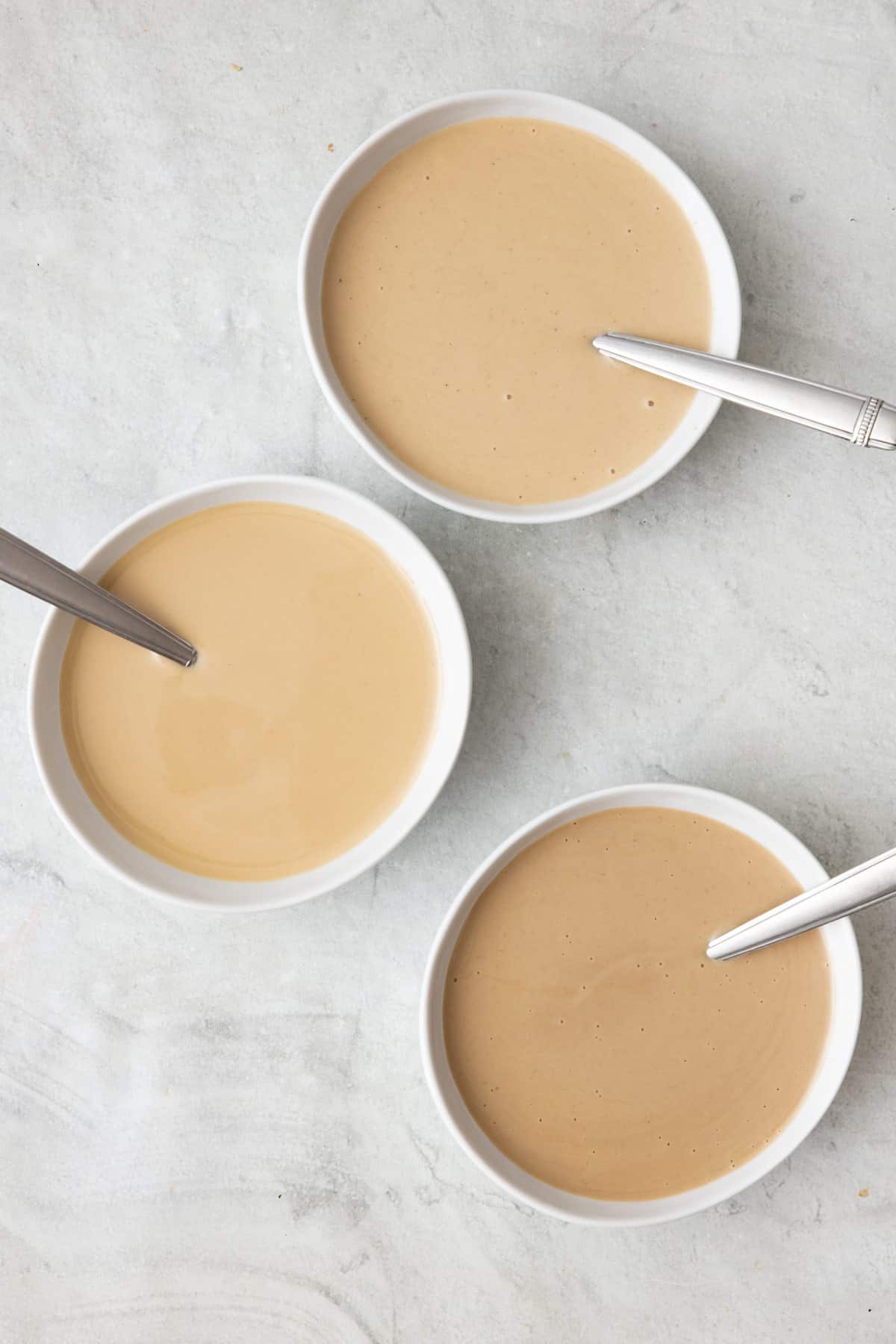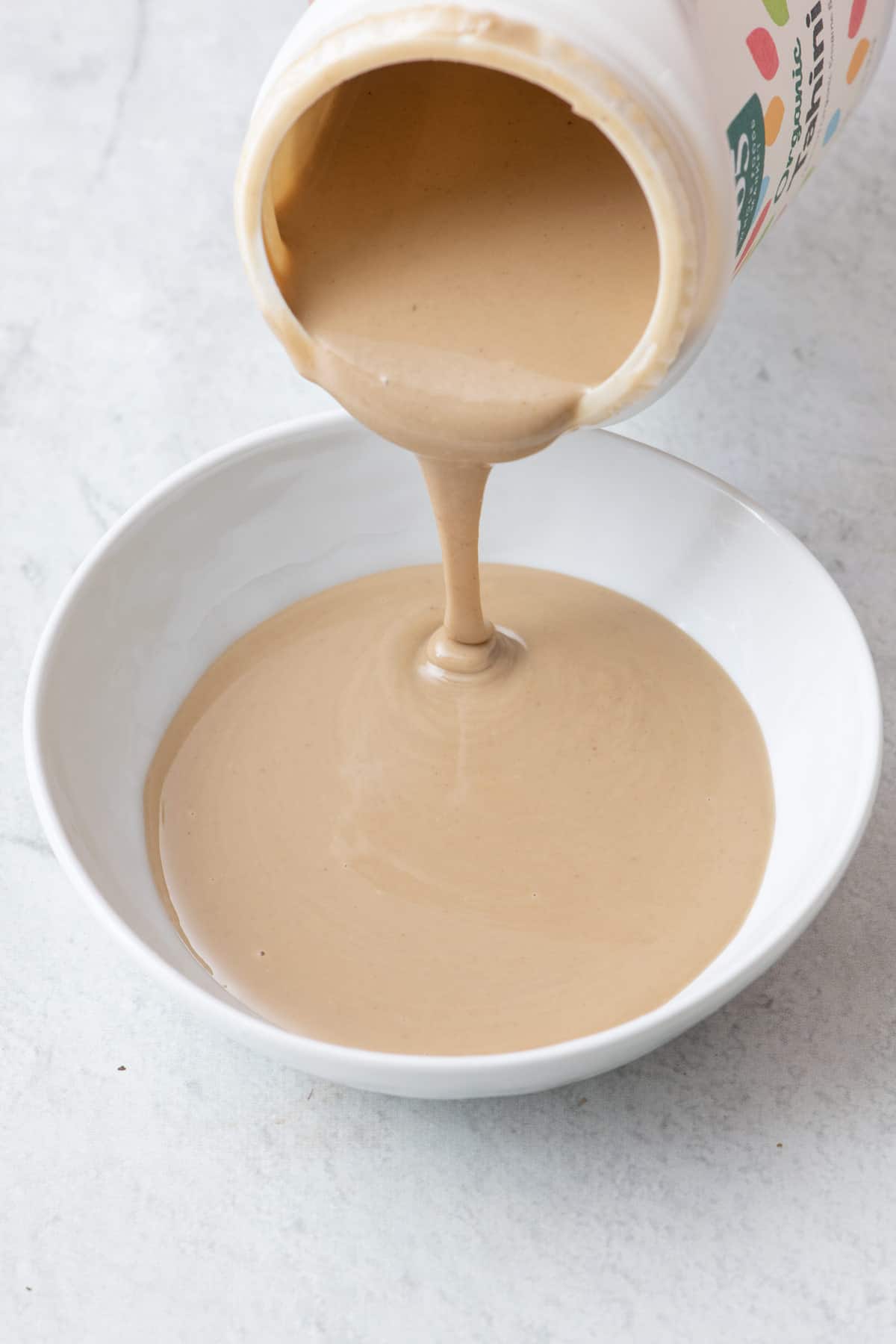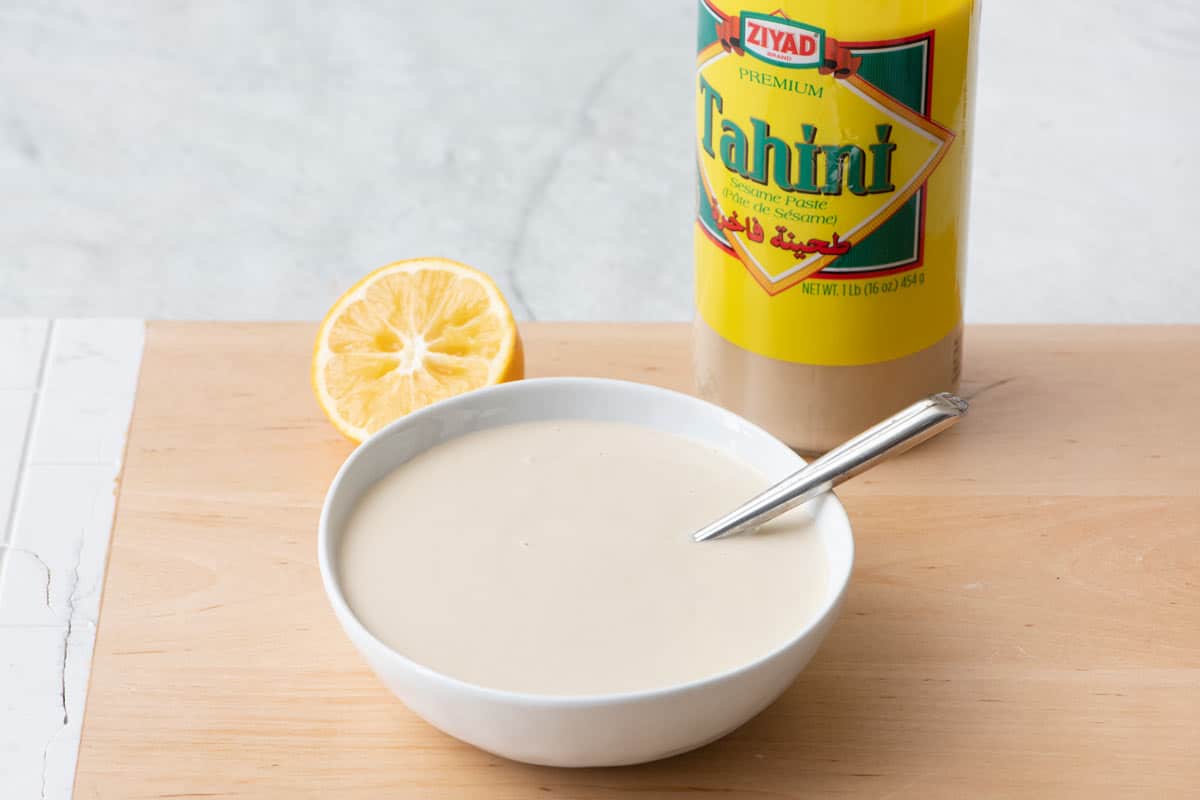This post may contain affiliate links. Please read our disclosure policy.
What is Tahini, you ask? Sometimes spelled tahina or tehena, it is a toasted sesame seed paste that has the consistency of a runny nut butter. Tahini is a delicious Middle Eastern condiment that can be used in many different recipes, the most common being hummus!

Jump to Section
What is tahini made of?
When making the best tahini, sesame seeds are the only ingredient you need! I’m not opposed to a little salt added, as it’s always a flavor booster.
Commercially produced tahini involves hulling sesame seeds by soaking them in salt water or mechanically processing them. After hulling, the seeds are roasted to intensify their nutty flavor and soaked again. This step helps to reduce bitterness and enhance the creaminess. Finally, the seeds are ground into a paste.
Some sesame seed pastes are made from un-hulled sesame seeds, which tend to have a slightly more bitter taste than usual. That also means they contain more nutrients since it uses the hull as well. Similarly, when tahini is labeled as “raw” it uses either unroasted seeds or seeds that have been lightly roasted, resulting in a milder nutty flavor.
What about other tahini types?
Chinese and Japanese cuisine also use a variety of sesame seed pastes that are commonly added to dipping sauces, noodles, sweets, and other dishes. Depending on the desired flavor and texture, these pastes typically use either black or white sesame seeds that may or may not have their hulls removed.

How do I use tahini?
I grew up on Lebanese cuisine, and without a doubt, tahini is a staple ingredient I couldn’t live without! You can find tahini in all kinds of classic Middle Eastern recipes like hummus and baba ghanoush, as well as tahini sauce, a must-have condiment for shawarma and falafel. It’s a favorite addition to salad dressings and countless other savory dishes.
This nutty paste isn’t just limited to savory dishes – it also appears in various sweets! Halva is a popular fudgy treat made from tahini and sweeteners like sugar or honey and is popular from Iran to Armenia.
Interestingly, U.S. chefs have recently discovered the unique and fantastic nutty flavor that tahini adds to baked goods like brownies and chocolate chip cookies, offering a delicious twist to classic desserts.
Tahini can easily substitute almond butter or peanut butter in many ways – spread it on sandwiches, use it as a dip for celery, or mix it into shakes and smoothies for an added boost of flavor and nutrition.

Is tahini good for me?
The tiny sesame seed is a nutritional powerhouse, offering a wide range of health benefits. According to Web MD, tahini is a great source of protein, fiber, and essential minerals like calcium, copper (for healthy blood), selenium (known for reducing inflammation), iron, and zinc, as well as vitamins B1 and B2. What’s more, over half of the fat found in tahini is heart-healthy and unsaturated.
Sesame seeds also contain sesamol, an antioxidant that has been shown to fight inflammation, as well as phytosterols that can help lower cholesterol levels. All in all, it’s a nutritious addition to recipes.
Difference between tahini paste and tahini sauce
Tahini paste is just ground sesame seeds. Period. In comparison, tahini sauce is made by thinning the paste to a consistency similar to a thick cream, typically by adding other ingredients.
My family’s recipe adds lemon juice, garlic, and olive oil to our tahini sauce. Other recipes may call for lime juice or vinegar, and water to achieve the desired consistency.

What are the best brands to buy
When I shop for tahini, I make sure to choose a brand that uses only one ingredient: sesame seeds. That’s it! Any brands that include added oils or artificial additives are a big no for me.
Additionally, I prefer tahini which is made from sesame seeds that are ground to a smooth and pourable consistency and are slightly runnier than peanut butter. To make sure that I’m getting the right texture, I check for a sludgy-like movement when I turn the jar over.
There are a few brands I love or can use in a pinch that are 100% pure ground sesame seeds:
- Ziyad – I love the consistency and authentic flavor of Ziyad’s tahini paste. It’s smooth, creamy and, has a wonderful nutty taste, and won’t separate when added to recipes. It’s my number one brand to buy.
- Mid East – This American brand of tahini has a great buttery taste and is extra smooth and creamy. It can sometimes be found at local grocers but is more easily available online.
- 365 Whole Foods – This one has a runnier consistency and usually requires a good stir to bring together the oil and paste. It’s perfectly nutty, just like you want your tahini to be, and isn’t overly bitter as it uses hulled sesame seeds and a little bit of salt.
- Al Kanater (not pictured) – This is an authentic Lebanese brand of tahini that’s rich and creamy with no additives – just pure roasted hulled sesame seed paste, perfect for all your recipes!

Recipes made with tahini
Tahini’s versatile flavor profile and consistency opens up a world of recipe possibilities with sweet to savory options. Below you will find a list of different recipes using tahini, and I’m sure you’ll find one to use up the jar sitting in your pantry!
Savory recipes with tahini
- Tahini Sauce
- Oven Roasted Cauliflower with Tahini
- Best Lebanese Hummus Recipe
- Lebanese Baba Ganoush Recipe
- Hummus with Ground Beef
- Best Authentic Hummus
- Avocado Hummus Dip
- Roasted Cauliflower Pitas
- Fall Harvest Salad

Sweet recipes with tahini
- Sesame Tahini Cookies
- Tahini Milkshake
- Tahini Chocolate Chip Cookies
- Sfouf (Turmeric Cake)
- Tahini Swirl Brownies

For even more recipe ideas, head over to my full list of Recipes with Tahini!
Frequently asked questions
No, it’s of a flavor all its own. While tahini has a nutty flavor and a similar texture to peanut butter, it doesn’t taste as sweet as most nut butters do and is meant to be nutty and a tad bitter.
Tahini made from unhulled sesame seeds can taste bitter due to the seed coating. To avoid bitterness, use hulled sesame seed tahini instead.
Yes, for a longer shelf life and to prevent your sesame seed paste from going bad, you should refrigerate it after opening.
It’s so exciting to see tahini popping up in salad dressings at fast-casual restaurants like Sweetgreen and even in recipes for brownies featured in food magazines!
It’s great to know that people are finally discovering this tiny toasted seed potential! With its complex flavor profile and nutritional benefits, tahini has been essential to the healthy Mediterranean diet for centuries. Which recipe are you going to try it in next?
For more cooking resources:
- How to Cook White Rice
- How to Cook Brown Rice
- How to Cook Quinoa in a Pot
- How to Peel Garlic
- How to Cook Chickpeas
- How to Make Oatmeal
If you’ve found this ingredient deep dive on What is Tahini helpful or if you’ve tried any recipe on Feel Good Foodie, then don’t forget to rate the recipe and leave me a comment below! I would love to hear about your experience with this technique. And if you snapped some shots of it, share it with me on Instagram so I can repost on my stories!






Many thanks for the great article! In my personal experience, tahini paste should never be refrigerated. Otherwise, condensation may shorten its shelf life. In contrast, what must be refrigerated and consumed within a couple of days is tahini sauce or “tartour”.
I’d also like to add that, in Iraqi cuisine, tahini paste and date molasses “dibs” are mixed for a filling breakfast meal. The ratio of tahini paste to date molasses remains at each person’s own discretion, so it’s a matter of taste and sweetness threshold. It’s a great treat. I sometimes eat it for dinner when I don’t have the time to cook anything for that evening.
That sounds so good! Thank you for sharing!!
Hi Yumna, can you provide a nutrional profile for Tahini eg. Carbs calories etc thank you
Hi Gillian, great question! The nutritional profile will vary depending on the brand you use, and to avoid misinformation, I opted not to include it in the post.